“Gynaeceum” is Greek and means ‘women’s chamber’. The word was originally applied to the section in an ancient Greek private residence that was reserved for women, had a number of domestic functions and, according to some sources, was possibly used as separate living quarters. In the Renaissance the word was used as a genre designation for a literary historical category: a catalogue of women who were notable by virtue of their writings or some other form of artistic or intellectual activity. The genre emerged as a development of, among other things, a work by the ancient Greek writer Plutarch, who had described women’s heroic deeds in historical events. Plutarch’s case studies were often those of collective and anonymous female endeavours, but they were nonetheless actions he thought should be remembered because of their crucial historical significance.
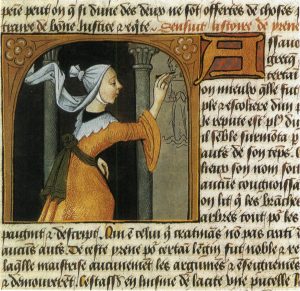
Among the extant works of the productive Italian poet Boccaccio (1313-1375), whose life straddled the transition between what is generally defined as the Middle Ages and the Renaissance in Italy, there is a tract entitled De virtutibus et vitiis feminarum (Of Women’s Virtues and Vices). This work is one of the early, and possibly even the earliest, “gynaeceum” we have. It is based on examples from classical antiquity and the Bible, and it takes a deeply moralising attitude by highlighting and demonising the female figures in order to motivate and deter others.
Later gynaecea often refer to Boccaccio and his less well-known colleague Johannes Bergamensis as pioneers of the genre, and as late as the mid-1700s their works were familiar in Denmark to those engaged with “feminae illustres”. The genre reached its culmination in northern Europe around the middle of the seventeenth century and for the next century or so, undergoing a shift from Latin to national languages. In its heyday, moreover, the genre concentrated on the famous women and left out the infamous ones. It thus came to be characterised by respect for women’s proficiencies; national pride shone from the pages on which the writer catalogued the learned women of the nation, and there was no attempt to disguise efforts to make the list as long as possible.
The gynaecea typically had a systematic or alphabetic structure, making them suitable as reference works. By looking up a famous woman’s name, the reader is introduced to her family via a few laudatory adjectives, her husband, or husbands, if there were any, occasionally her children – particularly if they became well-known as adults – and her own intellectual achievements. The information is often kept brief. The writer of the gynaeceum only had a name and perhaps the title of a single poem she had written. Judging from the information we have today, when we take a closer look at the stories of the women named, no great effort was made to find out more than what was immediately evident. The writings thus prove to be somewhat monotonous and uninspired reading. They are, nevertheless, our main source of information about the perspective on ‘learned women’, and without them we would not know where to begin searching for intellectual females.
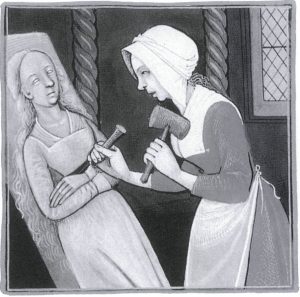
In a typical example, we have no extant writings from the learned woman’s hand, but the gynaecea provide us with the title of a couple of her lost works and information about which famous men poured posthumous praise on her for her talents. Everything for which she was renowned might have been presented in an oral tradition. However, she might well have been a cultural focal point, a character who gathered men and women in a forum for debate, a walking encyclopaedia, and a scholarly inspiration for coming generations; perhaps she had been known as a teacher, singer, painter, participator in theological debate, genealogist, or hymn writer, perhaps she was an anonymous translator, and so forth. Even the most meagre pieces of information in the gynaecea are much appreciated when attempting to track down these women. They provide a shortcut to the extant, but often neglected, evidence of women’s participation in cultural life. The evidence can be found in epitaphs, funeral orations and so on, and – if we are lucky – in unnoticed works, printed or not, written by the woman herself.
Gynaecea can be tracked down across Europe; individual works have to be sourced in the national bibliographies of each country, and it is a rare stroke of luck to find them listed as their own exclusive category.
An exhaustive catalogue of the gynaceum genre interpreted in a broad sense has been undertaken in Germany: Jean M. Woods and Maria Fürstenwald, Schriftstellerinnen, Künstlerinnen und Gelehrte Frauen des deutschen Barock, (Stuttgart 1984; Women of the German-Speaking Lands in Learning, Literature and the Arts during the Seventeenth and Early Eighteenth Centuries: a Lexicon).
From the period between 1606 and 1715 we have no fewer than eleven German gynaecea, six written in Latin and five in German. Numerous examples are found post-1715, written in German and more or less genre specific. Around 1800 the genre comes to an abrupt end.
The earliest extant gynaeceum dates from 1606. It was written in Latin by Martin von Baldhoven, and bears the title Catalogus doctarum virginum et foeminarum (Catalogue of Learned Maidens and Women). Baldhoven refers to seventy women, of whom seven are German. The first gynaeceum written in German was published in 1631 with the title: Die lobwürdige Gesellschaft der gelehrten Weiber (The Laudable Company of Learned Women); one hundred and twenty women are listed, of whom twenty-seven are German.
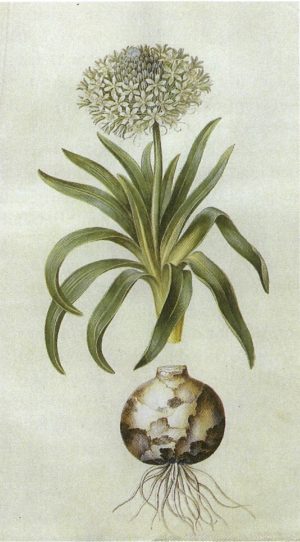
However, the time was not yet ripe for that kind of mother-tongue literature. The next publications were written in Latin. The first one to be looked at here is not primarily a gynaeceum, but rather a discourse on women and learning – one of the many tracts warning against allowing women to advance too far in the world of scholarship. The work was written by theologian Johann Sauerberg, and was called: Diatribe academica de foeminarum eruditione prior (Academic Discourse on the Education of Women, Part the First) It was followed by a ‘Part the Second’. Some of the arguments are based on the following precepts:
– It is not contrary to nature for women to study.– Women are, however, subordinate to men due to their biological composition of cold and wet elements, which has a negative effect on mental functions.– Only men may engage in areas such as law and theology, philosophy and medicine. It is, however, acceptable for women to be nurses.– Female sovereigns are legitimate, but their “status legalis” does not mean that this is a “status naturalis”.
The dissertation is oft-quoted, presumably because it seems to offer a scientific substantiation for its rejection of women’s admission to the major academic disciplines. Thirteen German learned women are named.
In his Latin treatise De eruditis Germaniae mulieribus (On the Learned Women of Germany), Christoph Christian Händel is favourably disposed towards female students from the nobility. Andreas Planeres also makes a comparatively positive contribution to the debate in his thesis, which was written in 1701 with Johannes Paschius as præses (a form of academic advisor or mentor, with a status corresponding to that of dean or professor, who was often the actual source of inspiration behind the thesis). The learned woman is here, however, still seen as an exception. Twenty-five German women are named.
In his 1692 Latin publication Centuria foeminarum eruditione et scriptis illustrium exhibens (A Collection of One-Hundred Women Famed for Their Learning and Writings), Christian Juncker proposes two ideas: men are not intellectually superior to women, and learning does not stimulate women’s immorality. Juncker was also probably the first non-Dane to mention Danish Birgitte Thott in his gynaeceum.
Around 1700 it became the norm for gynaecea to be written in the national language, which meant that more people had the chance to read and thus cite them. One of the really famous German gynaecea is Franz Paullinus’ Das hoch– und wohlgelahrtes teutsche Frauen–zimmer (The Highly Learned German Female) of 1705, which names two hundred and seventy German women. This was followed in 1706 by Johann Caspar Eberti’s Eröffnetes Cabinet deβ Gelehrten Frauen–Zimmers (The Learned Women’s Open Cabinet), which is copiously annotated and has an extensive bibliography. Six hundred women are mentioned, but only sixty of them are German. In 1715 Georg Christian Lehm published his Deutschlands Galante Poetinnen (i.e. German female poets writing galante Dichtung), listing one hundred and eleven German and one hundred and sixty-six non-German women.
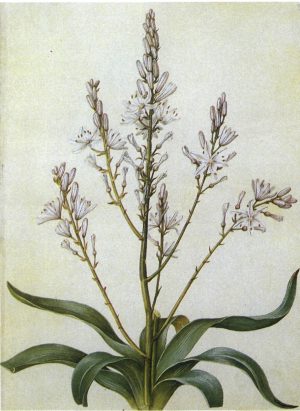
The last German publication to be mentioned here was also written in German, by Gottlieb Siegmund Corvinus (Amaranthes), and published in Leipzig in 1715: Nutzbares galantes und curïöses Frauenzimmer–Lexicon (Practical Galant and Sundry Encyclopaedia for Women). The copy in the Royal Library, Copenhagen, is endowed with Peter Frederik Suhm’s ex-libris stamp. The book is constructed as a handbook for women, arranged in alphabetic order. It is interesting to see the selection of terms and people that were thought appropriate for inclusion in a women’s reference book; for example: Tragebette (stretcher/bier), Rindfleisch mit Senff (beef with mustard), Gurcken (gherkins), Bratböcken (roasting spit stand), Briseis, Sappho, Birgitte Bilde.
Nordic Gynaecea
The Nordic region has an excellent collection of home-grown gynaecea. The genre is particularly well represented in Denmark. Sweden has preserved an eighteenth-century Swedish-language summary of a now lost Latin gynaeceum from the end of the seventeenth century. The Danish gynaecea not only deal with the Danish learned women, but also with a number of Norwegian women. There is little information from Iceland. A few women with connections to Finland are mentioned in the Swedish gynaeceum, and there might have been more in the lost original. We have no record of any Finnish gynaeceum, but we know that there was a sophisticated Neo-Latin culture centred on Åbo Akademi in the mid-seventeenth century, and even though we have, as yet, but faint traces of women who asserted themselves in the Finnish cultural life of this period, it is almost inconceivable that they were not active and involved. Something similar applies to the neo-Latin milieu in northern Iceland, where the episcopal residence at Hólar in Hjaltadal, with both grammar school and printing house, was a centre of scholarship on a par with a high European standard. A few women’s names feature in connection with this milieu as scribes or are mentioned in the poems, but hitherto not as named authors.
Not all the Danish gynaecea fulfil the requirements of the genre, but they all show that their authors were familiar with the genre, and that there were women in the Nordic region who considered themselves members of the European ‘club’ of cultured women.
The earliest Danish contribution known to have survived is Anders Bording’s poem Scutum Gynæcosophias eller lærde Quinders Forsvar (scutum is the Latin word for ‘shield’, gynæ comes from the Greek gyno, gynaikos meaning ‘woman’ and sophia is Greek for ‘wisdom’, thus: the shield of female wisdom, or a defence of learned women). In his lifetime, Anders Bording (1619-1677) was known for his poems in Danish, this one included. They must have been circulated among his fellow poets and other readers, even though a published edition did not appear until 1735. Lærde Quinders Forsvar is cited on a number of occasions prior to its publication. The poem is witty and double-tongued. His defence is not unconditional and he writes frankly and ironically about the learned women’s lack of learning. In the course of his several-hundred-verse-long poem he takes it upon himself to examine the talented women of world history; his difficulties in finding any must be due to an urge to forget the ones who have existed. Bording is an early example of the male anxiety of intellectual inferiority to a woman, which so often emerges either directly or indirectly in the discussion about learned women, although here the view is not presented as his own but as that of “the common rabble”:
The book-learned woman
Is loose-living, and becomes
Far too clever for her husband
And makes a mockery of him.
Of Danish women, Anders Bording only names Birgitte Thott, “The noble Tot [tuft/wisp], who is so learned,” and her mother, Sophie Below, and possibly her mother’s sister Marie Below, “and she of Belov’s stock/ who is so highly prized and valued”. Otherwise he can only recall a girl on the island of Funen, who could recite the New Testament from memory, in Greek, “but I know not the name” – this might, of course, be meant to suggest that the claim was not true. He wrote the poem in 1647, and yet there is no mention of Sophie Brahe, Tycho Brahe’s sister, whose exceptional scientific talent should have made her a natural candidate for his consideration.
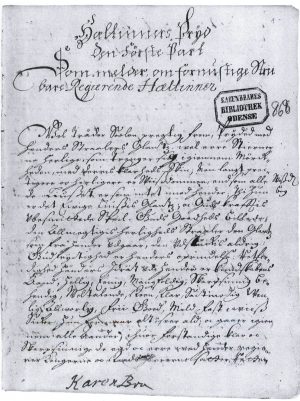
The gynaeceum genre is normally a male preserve. It would be immodest to write a eulogy to one’s own sex. The mere act of replying to a male scholar’s enquiries about qualifications for use in a gynaeceum struck some women as too self-assertive by far. It is thus of even greater interest that the collection of Danish gynaecea includes one written by a woman: the daughter of King Christian IV, Leonora Christina Ulfeldt’s Hæltinners Pryd (Adornment of Heroines). It is perfectly likely that Leonora was familiar with a work by a female predecessor in the genre: Madeleine de Scudéry’s two-volume Les Femmes Illustres, ou Les Harangues Héroiques (Les Femmes Illustres or the Heroick Harangues of Illustrious Women), published in 1642-44 under the name Monsieur de Scudéry, this being her brother Georges. It is an unresolved issue as to how much of the work Madeleine de Scudéry wrote, but in her lifetime it was already presumed to have been a joint project, and sections of it can convincingly be attributed to her pen: for example, the self-portrait in the depiction of Sappho in Les Femmes Illustres, which appears again in her later work Artamène, ou le Grand Cyrus. It must have been a pleasure for Leonora to write in her own name. Leonora Christina was not one to hide her light under a bushel. Her pride is legendary. It surfaces again and again in her major work, Jammers Minde (Memory of Lament), and without it she would undoubtedly not have survived her two decades of imprisonment in the Blue Tower – or, indeed, perhaps she would have been released far earlier.
Leonora’s Hæltinners Pryd was in all probability written during the period between 1671 and 1684, while she was imprisoned. Her doctor, Otto Sperling, was imprisoned on another floor in the Blue Tower – thanks to his good relationship with Leonora and her husband Corfitz Ulfeldt, who was thus responsible for the incarceration of them both. Over the years, Otto Sperling’s son, also called Otto, visited his father and Leonora in their captivity, and when his father died in 1681 he continued to visit Leonora. He provided her with literature and inspiration for her writing. Otto Sperling Jr. was himself engaged on a major work in the same genre.
Leonora’s original plan had been to write a work “on every kind of laudable female person”. She lists nine categories of women, but does not think they can all be called ‘heroines’, whereupon she limits herself to three groups: the contentious (the courageous), the faithful and chaste, and the persevering.
Leonora Christina’s gynaeceum Hæltinners Pryd (The Heroines’ Praise) is divided into three parts: “The first part is to the honour of valiant heroines. The second part speaks of true and chaste heroines. The third part of steadfast heroines,” she tells us in Jammers Minde. Only the first part survives. We have always known about the existence of the work, but it was not published until 1977, by Christopher Maaløe.
Only the first of these survives. The original has been lost, and the extant copy is full of errors. The manuscript is kept in Karen Brahe’s Library. At the time of Leonora’s death it was known to a wider public and was, for example, mentioned in a short obituary in the journal Nova Litteraria Maris Balthici et Septentrionis (Literary News from the Baltic and Nordic Countries]. The edition published in 1977 refers to a number of models and sources on which the work was based, one of the most important being Pierre le Moyne’s La Gallerie des Femmes Fortes (Paris 1647; The Gallery of Strong Women). In terms of structure, she followed the method that had been common since Plutarch’s biographies of famous Greeks and Romans, arranging her heroines in pairs so they could illuminate one another.
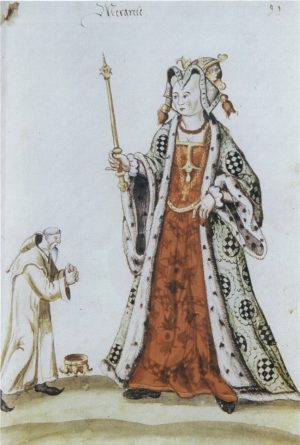
Leonora thinks it perfectly reasonable that women should be rulers, and most of her courageous heroines are in power. The preface is full of bombastic views stated as fact, with no further discussion. Unlike her royal ‘colleague’ in Sweden, Queen Christina, she is of the opinion that women are particularly suited to holding the reins of power. Good leadership is not a question of physical strength:
“The ability to rule is not found in coarse limbs or strong sinews; they do not beget counsel and good and useful thoughts.”
What really counts is intelligence and experience: “wisdom”. By virtue of this, women have “tamed wild and furious people, made them weak, meek, amiable and governable”. She is annoyed by the misleading use of words such as ‘womanish’, ‘manly’, and so forth, which link certain abilities and shortcomings to one sex regardless of the fact that they are often applicable to the other sex: “How often do we not see womanish hearts in men’s bodies and, on the contrary, masculine strength in weak vessels. It is unreasonable to measure deeds by the person and not appreciate the person by the deed.”
Her heroines are taken from the Bible, from history as told in the legends and from documented history. They are all described briefly and to the point with literature references, often with translated passages from her sources, and she adds her own views directly and unapologetically. With her feminist ideas, she is noisier and more demanding than her immediate predecessor in the field, Birgitte Thott. She pays no diplomatic regard to readers who do not share her convictions. Where Birgitte Thott, as we shall see, moralises in a pedagogic and strategic manner, Leonora tells us what is what in a loud voice.
Historical veracity is not a goal in itself for Leonora. She is far more interested in getting her point across. Her central purpose is to nominate women who have taken responsibility in their lives and performed feats of which hardly anyone would have thought them capable. The heroines are generally prudent, composed, brave, down-to-earth, loyal to their country and faithful to their husbands. They are preferably of royal blood. If they enter battle then they are triumphant even when in defeat. Of the medieval maiden Hetha, who was in the service of the Swedish king, we learn how she was given regency over Denmark, but voluntarily relinquished it because the Danes were bored under her peaceful rule and wanted a male regent instead. It was worse for the Danes, in her opinion: “How fervently the inhabitants of the realm of Denmark did regret having displaced Hetha is recounted in the History of the Danes. Thus, too, does Albert Krantz write: it was not as easy for them to get Hetha back again as it was to displace her.”
It would have been fascinating to read the whole of Leonora’s work, but we must be content with her “contentious” heroines.
With pious indignation, Leonora describes the infantile teasing her heroine Queen Margrethe had to endure when she prepared for defence against King Albrecht of Sweden’s military offensive: “When King Albrecht learned that Queen Margrethe, with her loyal men, was preparing to receive him, he became scornful and let fall many an invective. He called her Queen Trouserless, Margrethe Monk’s Mistress, because she was generous towards the Church and the clergy, sent her a long whetstone with which to sharpen her scissors and her sewing needle, showed her over to the spinning wheel […]. But Margrethe was immune to this; she was far too noble to allow her regal dignity be sullied by invectives and slanderous gossip […]”.
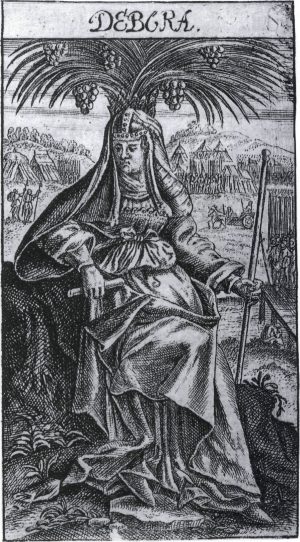
Leonora was in contact with the aforementioned Otto Sperling Jr. (1634-1715) throughout the period during which she wrote her gynaeceum. He was working steadily on his own gynaeceum, a large-scale work that remained unfinished at the time of his death. They exchanged material and discussed whenever they met. Otto Sperling Jr. lived in Hamburg from 1673 until 1681, where he wrote a historical work on the city, so the number of times they met was restricted in this period – given that Leonora was unable, for good reason, to visit him. Leonora would not have been able to write her work without Sperling’s participation, although we do not know if he also gave her the idea, or vice versa. The threads of their working partnership are difficult to unravel. Sperling encouraged his father in the Blue Tower to write his autobiography at about the same time as Leonora was writing her autobiography in French, which Sperling translated into Latin, presumably to be able to distribute it abroad. Sperling and Leonora also follow on from one another in the series of tribute poem writers in Dorothe Engelbretsdatter’s Siælens Sang–Offer (Song Offering of the Soul) in 1685. And Sperling must have known about the writing of Jammers Minde; he might even have helped her with it. They maintained their contact after Leonora was released and moved to Maribo Monastery. It was a lifelong friendship between two generations.
Otto Sperling Jr. was a collector, an old-fashioned polymath, and was especially interested in coins and women. The unmarried gentleman had a collection of learned women comprising 1,399 brief or longer biographies written in Latin. They have survived in a two-volume manuscript at the Royal Library in Copenhagen: De foeminis doctis (On Learned Women). Sperling collected women from all countries and all eras. He kept in touch with foreign scholars and with Danes abroad, and he was provided with information when one of his contacts came across an interesting learned woman, dead or alive. The collection grew steadily, rapidly during some periods, judging by the registration date of the most obvious Danish candidates.
Sperling’s significance lies primarily in his views on women and his propaganda on behalf of the learned women. His surviving and extensive correspondence in many languages includes letters written in Latin on the subject of women to, for example, Tormod Torfæus and Johannes Moller. Among topics discussed is the definition of ‘a learned woman’. Traditionally, one of the most important criteria was facility with the classical languages: Latin, Greek and Hebrew. Some could, however, get away with just Latin. Writing in the national language came into favour during the seventeenth century to such an extent that the criteria for erudition had to be revised. Sperling thus took the view that a woman who could write an elegant poem in her mother-tongue should be entitled to an entry in his gynaeceum. Not everyone agreed with this view, but Sperling nonetheless stuck to it. The assembly of learned women was thereby considerably expanded, which was naturally to the women’s advantage. Sperling had no desire to include as few as possible, nor to treat them like superhumans or – more importantly – as exceptions. He had no fear of learned women. He preferred them!
With this rare interest, it is hardly surprising that he took particular pleasure in exchanging letters in Latin with a number of female correspondents. His surviving papers include letters to and from women, of which those in Latin must certainly comprise the largest collection of such letters in the Nordic region.
Otto Sperling Jr. exchanged letters in Latin with Norwegian Cille Gad, Danish Anne Margrethe Qvitzow and Anne Margrethe Bredal, Swedish Sophia Elisabet Brenner and most likely Italian Helena Piscopia Corner.
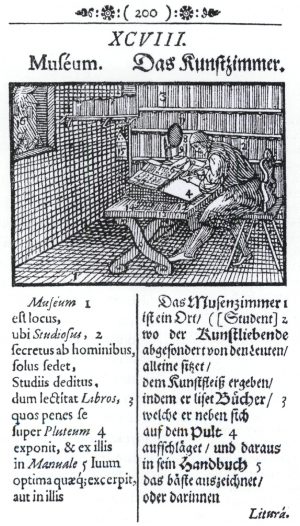
An only ten pages long gynaeceum on Denmark’s learned women has survived from the year 1700, when it was written in Latin by Matthias Henriksen Schacht (1660-1700), who at the time was headmaster at the grammar school in Kerteminde. This is the earliest published gynaeceum we have, given that Bording’s had to wait a century for publication. Schacht called his tract Schediasma, exhibens specimen de Eruditis Mulieribus Daniæ (A General Essay on Denmark’s Learned Women) and had it published in the journal Nova Literaria Maris Balthici et Septentrionis (Lübeck 1700). Schacht first lists nineteen European gynaecea and then thirty-six Danish learned women, which was all he had been able to find. The article concludes with an enthusiastic exclamation: “Vivant litterae! Vivant Fæminæ in Dania literatæ!” (Long live literature! Long live book-learned Danish women!)
The learned women had come to stay.
The next gynaeceum was also written in Latin: Albert Thura’s Gynæceum Daniæ Litteratum (Denmark’s Learned Women’s Chamber), published as an independent book of nearly two-hundred pages in Altona in 1732. Albert Thura (1700-1740) was a church minister in Lejrskov, and is today known for a work on early Danish literary history, written in Latin. As a by-product of his studies in literary history, he gathered material about women who had in some way or other made a favourable impression by virtue of their intellectual or artistic achievements. He followed in Otto Sperling Jr.’s footsteps in his appreciation of writing in the national language, and he would probably not have reached the round number of one hundred women, of which he was immensely proud, had he not looked beyond the circle of writers skilled in Latin.
In an appendix to his Gynæceum Daniæ Litteratum (Denmark’s Learned Women’s Chamber), Albert Thura lists a lot of ‘leftovers’ of learned women who were not included in the one hundred. Of these, one is Icelandic, Thurida Snorresdatter, and lived around year 1100. In the introduction he has listed female patrons and founders of endowments. The endowments are often very limited – typically being free paper and pens for one pupil for one year.
Albert Thura did not merely copy from earlier sources. He was familiar with these sources and used them, but he also undertook extensive investigative work by writing to clergy and scholars in order to gather information about specific women, or to get ideas about those with whom he was not familiar. He also visited Karen Brahe’s Library in Odense, where he spent profitable time reading books and manuscripts penned by the literary women. Here he found, gathered in one spot, literature written by and for women, and he was annoyed at only being able to spend a short time there. He refers to the library with great respect at several points in his gynaecuem. As he was not in a position to stay and work there, he obtained permission to send a representative to go through the collection thoroughly, looking for material on his behalf.
Albert Thura had good use of Karen Brahe’s Library in Jomfruklostret, Odense, when he wrote his Latin work on learned Danish women, Gynæceum Daniæ litteratum, printed in 1731:
“The attention and favour shown me last summer by your most noble Madam – when on my journey to Copenhagen I was so fortunate as to see the excellent and pleasant Danish Library housed, to the credit of the whole nation, at the noble Jomfru-Kloster in Odense – will never be forgotten by me, but will remain a remembrance for which I am eternally grateful for as long as I shall live. I have often since been displeased with myself that time did not allow me to profit more from the good fortune I had in my hands, that I could have seen and read some of the beautiful handwritten books kept there.”
(Letter to Karen Brahe, dated 27 January 1728).
Albert Thura’s publication was the last gynaeceum to be written in Latin in the Nordic region. Thereafter, they were printed in the national language – and, at the same time, the genre changed character. Frederik Christian Schønau (1728-1772) published his Samling af Danske Lærde Fruentimmer (Collection of Danish Learned Women) in 1753. It is a veritable exercise in footnotes, with more notes than main text, which would be fine if the footnotes shed additional light on the learned women and their works. This, however, is not the case. Schønau has produced a huge work on one-hundred Danish women, all of whom he doubtless held in high esteem. His admiration, however, is patronising. He is the women’s heroic champion; he feels sorry for them and is concerned about their lot in life and their wretched circumstances. And then he often forgets about them in favour of his many scholarly footnotes. Although it has to be handed to him: he forges the transition from the Latin gynaecea to the Danish-language history of women’s literature; he disseminates much of Thura’s material in Danish, and also supplements it with many short poems by and about women. He begins with an extensive and solid Danish-language introduction to the European gynaeceum tradition. Not all of Schønau’s one-hundred women are the same as those listed by Albert Thura. Approximately one quarter of them are replaced by new names, which he thus places in their proper context.
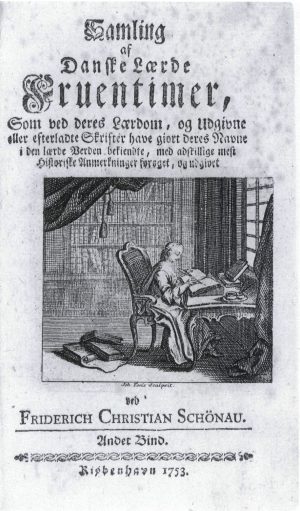
Schønau was succeeded in the genre by H. J. Birch, whose Billedgallerie for Fruentimmer (Picture Gallery of Women) was published in 1793-95. Volume 1 is devoted to national material, while the next two volumes cover the rest of Europe. However, only a small part of the first volume is a catalogue of famous female individuals, and of these only a few are artists or scholars. H. J. Birch used the genre more as a pedagogic treatise with moralising instructions to respectable wives, expectations of whom were limited to good housekeeping rather than individual intellectual achievement.
From Sweden we only know of one surviving gynaeceum written in Swedish. In fact, it is an updated summary of an earlier and lost Latin work written by kansliråd (an official in a state ministry) and riddar (nobleman) von Stiernman. Stiernman’s work is referred to as Gynæceum Sveciæ Litteratum (Sweden’s Learned Women’s Chamber). The summary was published in 1780 as an article in Magnus Swederus’ journal Stockholms Magazin. A Latin dissertation, Exercitium academicum Mulieres philosophantes leviter adumbrans (1699; An Academic Exercise that Lightly Touches on Women Who Philosophise), by Petrus Hedengrahn and Johannes Esberg, is an earlier example, in a different genre, of positive interest shown in Uppsala for learned women. The preface to the dissertation is dedicated to the poet Sophia Elisabet Brenner, a Swedish exemplar of a “femina illustris”.
Swederus’ gynaeceum is structured as an article listing the women in alphabetical order. It is somewhat similar to a Danish gynaeceum by Matthias Henriksen Schacht. Swederus presents brief biographies of twenty-three women, including well-known figures such as Sophia Elisabet Brenner, Maria Gustava Gyllenstierna, Maria Aurora Königsmarck and Hedvig Charlotta Nordenflycht. However, neither Agneta Horn nor Queen Christina is named. Nor is Christina mentioned in a letter from Otto Sperling Jr. to Elisabet Brenner, in which he lists the Swedish learned women with whom he is familiar, even though he included her in his own gynaeceum, De foeminis doctis. Perhaps, having spent so many years living abroad, she was no longer considered Swedish.
Among the other women on Swederus’ list, which is the basis for the following overview, some are merely named because of their fame through kinship (as wife, mother, or grandmother) with famous men. Others are the authors or collectors of family books and heraldic writings, as was the case in Denmark and Norway, or they are the translators of theological works or hymn writers such as Anna Catharina Wefwerstedt, married in 1732, who translated Christeliga och hjertrörande Betragtelser öfver Döden (Christian and Moving Meditations on Death). Christina Juliana Oxenstierna (1661-1701) falls completely outside the normal parameters of the genre; she is included by virtue of her dramatic personal story: falling in love with a man beneath her in social status, and eventually marrying him. Her entry is the most detailed of them all, and has clearly run away with the author, which makes for fascinating reading but is not particularly relevant in the context. Elisabeth Stierncrona published two stout volumes of spiritual observations in 1756 and 1761, which genre-wise correspond to the Danish ‘Spiritual Meditations’ and the like. Eva Maria Frölich preached sermons and disclosed her religious revelations, in which she featured as a victorious military commander. She ended up in prison and was later banished to beyond the borders of the realm; she returned to Sweden in 1692, whereupon she was placed definitively behind bars. A slim collection of her poems was published in 1684, written in German; it was banned on account of its content.
Anna Maria Wattrang won her fame in a completely different genre. She was the daughter of an artist and became one of the few women we know to have been renowned as a painter in her lifetime, producing, among other works, portraits of prominent men. Anne Krabbe from Denmark is named for her drawings at Kronborg, but otherwise there are very few references to women’s activities with paintbrush or chisel in the Nordic countries.
Two of the less well-known seventeenth-century women would seem to have had learning of a high international standard: Catherina Burea and Wendela Skytte. Catherina Burea spoke and wrote Latin, including letters to Wendela Skytte, it is said. She had musical ability, was beautiful (until struck by smallpox) and knew how to run a household. These latter two qualities, it is pointed out, are rare in learned women, even though we have a number of examples of learned women who ran a household and felt that they coped satisfactorily. Catherina Burea voluntarily attended to her father’s housekeeping for years, but eventually got married and had six children. At one point, she accompanied her father to Åbo in Finland, and within a year she was able to speak Finnish. It is surely not improbable that in the environment of Åbo Akademi she would have had women ‘colleagues’?
Wendela Skytte died in childbirth at the age of twenty, but by then she had managed to learn Latin, French, and German to a high standard, and her Greek was quite decent. She was accomplished in matters of theology, ethics, history, philology and geography. It is said that she was taught by means of the natural approach, by her father, which is in all probability true given that she was born into a milieu that fostered ideas from the European humanists Thomas More, Erasmus of Rotterdam, and Juan Luis Vives – and, as we have seen, in these circles girls were often taught personally by their fathers, using a deliberately gentle form of pedagogy.
Two of Swederus’ listed women were of an earlier date. They were abbesses at Vadstena Convent, to which Saint Birgitta’s mortal remains had been taken and where the Birgittine nuns lived in an environment that was both holy and intellectual. One of them, Margrethe Klausdatter (d. 1486) or “Margareta Daughter of Claus Night and Day”, as Swederus so elegantly names her, wrote about Birgitta in a work published posthumously by Eric Benzelius in 1710. The other, Anna Fickesdotter Bylow (d. 1519), wrote a family history, also published posthumously.
This small collection of Swedish biographies, and the quite numerous Danish and Norwegian biographies included in the Danish gynaecea, makes for a picture of active artistic and intellectual circles of women in these Nordic countries during the seventeenth and eighteenth centuries. And we can only presume that the same could be said of Iceland, the Faroe Islands and Finland. In numbers, not many were remembered and recorded; in political influence, their power was very limited. However, their significance in terms of the history of mentality, the history of women and, European cultural history is still far from charted and will gradually, as the individual lives are traced as far as is possible, colour the picture of Scandinavian cultural history.
Translated by Gaye Kynoch

